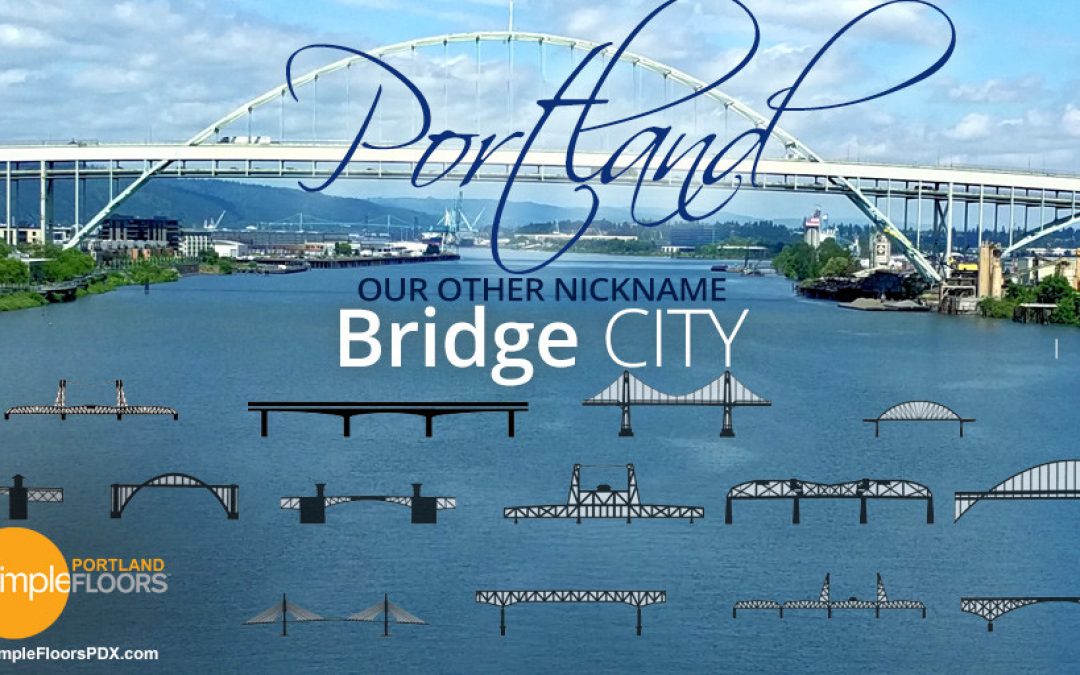For anyone who has ever flown into Portland with a view of downtown and the Willamette River, there is no question as to why the Rose City is also known as Bridge City.
The year was 1887 when the original Morrison Bridge was completed. At the time, it was the longest bridge west of the Mississippi River. Today, a total of 12 bridges span across the Willamette River as it runs through Portland splitting up the Westside of the city, where downtown is located, and the Eastside, which leads to Portland International Airport.
What Are The Bridges Of Bridge City PDX?
From West to heading East through Downtown Portland, here are the 12 various bridges that make up what is known as Bridge City:
- John’s Bridge
- Burlington Northern Railroad Bridge
- Fremont Bridge
- Broadway Bridge
- Steel Bridge
- Burnside Bridge
- Morrison Bridge
- Hawthorne Bridge
- Marquam Bridge
- Tilikum Crossing
- Ross island Bridge
- Sellwood Bridge
What Are Some Of Portland’s Most Unique Bridges?
One of the most unique bridges and frankly one of the most photographed bridge, is the 408-foot-tall Gothic looking St. John’s Bridge. Towering above its neighbors, the St. John’s Bridge is the only suspension bridge in the Willamette Valley. On the Eastside base of the bridge sits the popular Cathedral Park which plays home to many of Portland’s festivals such as the Pirate Festival.
Another unique bridge in the City of Roses is the also the newest addition to Bridge City. It is the newly opened Tilikum Crossing, which opened in 2015 to anything but cars. This unique bridge, which is located just East of downtown, is open to Portland’s award winning public transit system which includes, buses, light rail, street cars, and bicyclist and pedestrians.
The Hawthorne Bridge, which is Portland’s oldest public transit bridge (the previously mentioned Morrison Bridge was morphed in both 1905 and 1958 to its current state), is the oldest vertical lift bridge still in operation in America today. The bridge is one of the most heavily commuted bridges in Portland as well, with an estimated 1,500 bicyclists alone traveling to and fro each day on the bridge.
What Are The Oldest Bridges In Portland?
With the Hawthorne Bridge being Bridge City’s oldest public transit bridge, with what remains from the earliest era of Portland bridges, the Burlington Northern Railroad vertical truss bridge opened in 1908. It is also known as the St. John’s Railroad Bridge and is exclusive to locomotives.
In 1912, Portland’s hardest working bridge, as noted by The Oregonian, the Steel Bridge opened. This unique double-decker bridge plays host daily to literally anything that moves.
While Amtrak, freight cars, cyclists, and pedestrians utilize the lower deck each day, at the same time on the upper deck, cars, buses, and light rail move about as it crosses the Willamette River connecting Old Town Chinatown on the Westside to the Rose Quarter on the Eastside.
A year later, in 1913, yet another bridge was completed. The Broadway Bridge stands out with its unique red color and at one time, was the longest drawbridge of any type in the world.
What Does The Golden Gate Bridge and Portland Have In Common?
With the Roaring Twenties in full swing, the year 1926 brought Portland the Burnside Bridge. Seemingly located in the middle of everything, this bridge is also made famous by its architect Joseph Straus, who also was the architect for the famed Golden Gate Bridge in San Francisco.
The Burnside Bridge, which is also a draw bridge, offer commuters who are heading west into downtown a front-row seat to the famed Made in Oregon sign with deer in it. Kids of all ages especially love the deer during the holidays when its nose lights up red. Housed just underneath the bridge as it makes landfall on the Westside is famous Saturday Market and just east of the bridge along the waterfront, plays host to many of Portland’s festivals.
What Are The Busiest Bridges In Portland By Car?
Essentially bookending downtown Portland between the St. John’s Bridge and Tilikum Crossing are two of Portland’s busiest bridges to travel by car.
The Marquam Bridge, which carries 136,000 motor vehicles per day, is not only the busiest bridge in Portland, but also in the entire state of Oregon. For travelers heading North and East on the bridge via the upper deck, passengers in those vehicles are treated with multiple of views of downtown Portland, as well as Mt. Hood and Mt. St. Helens. Though what this PDX bridge makes up in effectiveness, its concrete and steel construction looks like a 1960’s attempt at what the future will look like. Coincidentally, the bridge was built in 1966.
Bookending the opposite end of downtown is tall and looming Fremont Bridge, which always stands out with the flags hoisted atop. The Fremont Bridge is also the second largest tied-arch bridge in the world. The bridge is also the longest bridge in the state of Oregon.
As you can see, there is no question as to why the City of Portland, Oregon is also known as Bridge City. And, because Portland is so pedestrian and bicyclist friendly, there is a lot of access to most of these bridges, even if it’s just the perfect spot to take a photo for your Instagram or Facebook page.







